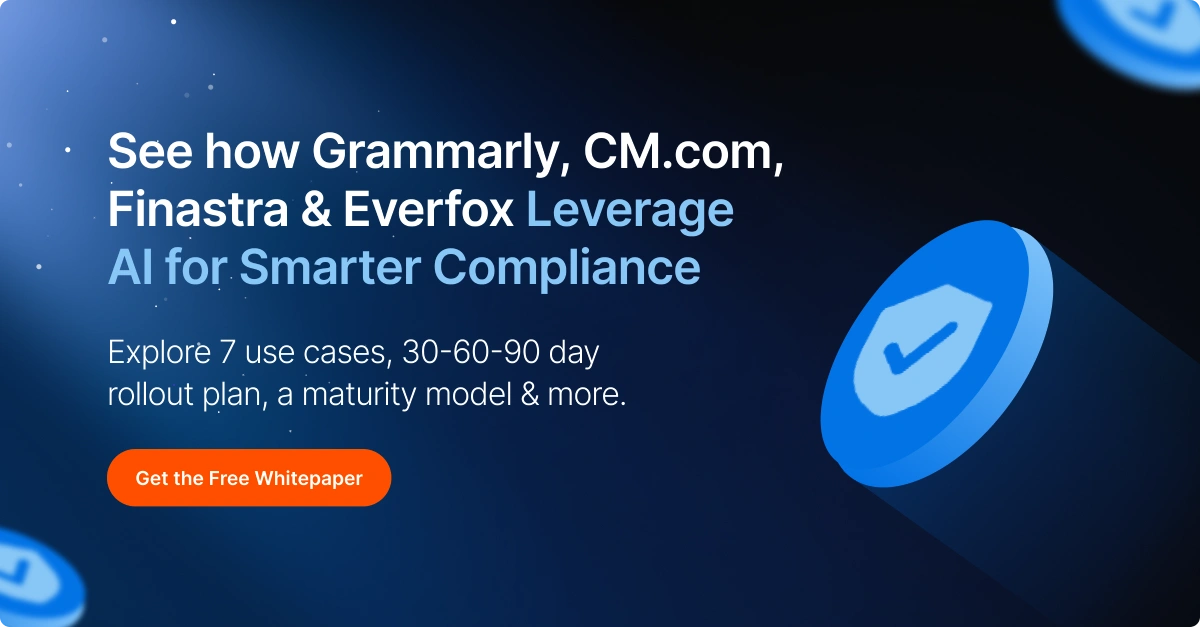If you’re here as an aspiring mid-level or entry-level GRC professional—or even someone looking to break into GRC cybersecurity with dreams of becoming a CISO down the line—then there’s some news for you: the not-so-good and the good.
The not-so-good news? The path ahead isn’t as straightforward as you might hope. The demands from entry-level roles are specific to each role, and most of them, mandate a certification or previous experience in technology. And to top it off, there are no generally accepted pathways to follow or principles to learn.
The good news? Amidst the chaos, there is structure, and our data reveals it. By analyzing hundreds of job postings on LinkedIn across all levels of cybersecurity, we’ve identified key trends and patterns that can guide your career decisions. These insights help you place more secure bets in an unpredictable job market, providing clarity and direction where it seems lacking – maximizing your chances to tap into the massively rewarding opportunities in the landscape.
So let’s dive in:

Unlike other fields, job shadowing might not work
As a CISO and the author of Navigating the Cybersecurity Career Path (Wiley), Helen Patton agrees that she never imagined she would be a CISO when she started as an IT admin. But with a few certifications and a college degree down the road, she found herself chairing the seat of CISO at Ohio State University after a tenure of 10 years.
“Asking someone how they got to their current security job is a great way to break the ice and build a relationship. It is interesting to know how someone made their way through the maze of security functions, corporate politics, and human error to land in their current role. The thing to remember is that a person’s story is just that — their story — and is not something that you can copy for yourself.” – Helen Patton, CISO, Ohio State University.
Yet, there’s a massive opportunity…
Those willing to navigate these twists are stepping into a field where the demand for GRC professionals has exploded, with more job openings, higher pay, and a growing emphasis on GRC expertise. Companies are increasing their hiring budgets for GRC, and the flexibility to transition between specializations within GRC today puts you in control of your career journey like never before. A rarity in most other industries!
The demand is exploding
Analyzing the keyword search trend on different platforms like LinkedIn and Google, interest in GRC positions like GRC Analyst, Virtual CISO (vCISO), CISO, and Information Security Analyst has exploded, witnessing unheard growth figures like a 1000% uptick in the last five years.
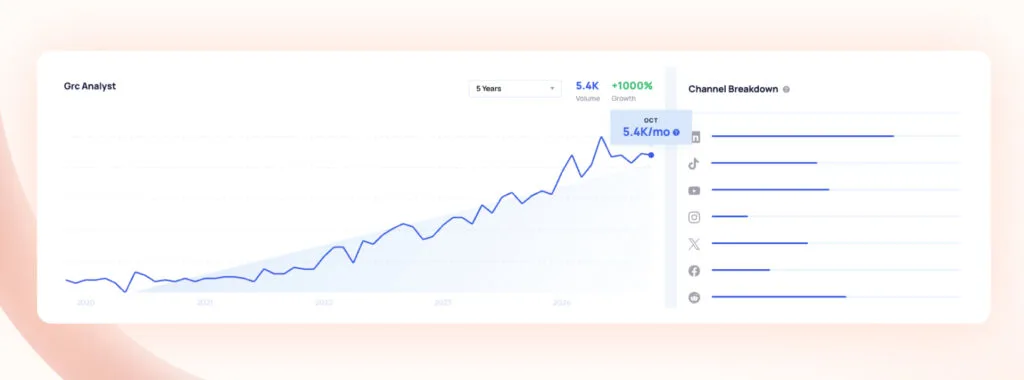
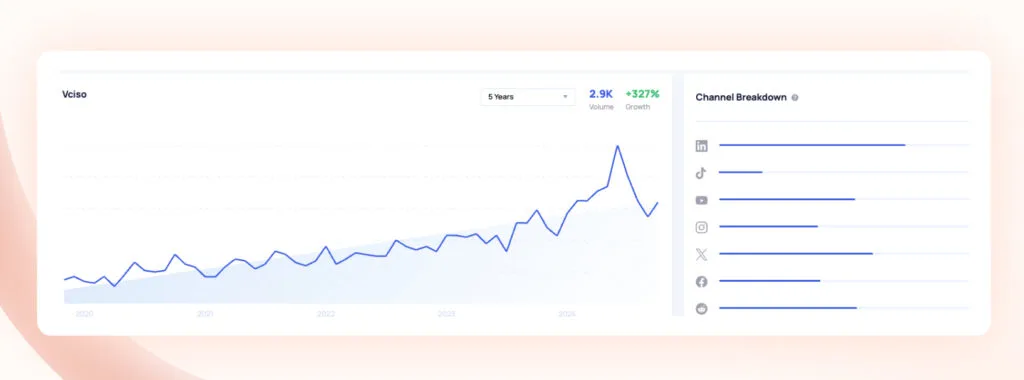
To put this growth into perspective, the cybersecurity workforce expanded between 2022 and 2023, adding nearly 440,000 new positions globally, as per an ISC report.
Pay for top GRC roles is on the rise
The data on median salaries speaks volumes about the sector’s growth and the premium placed on skilled professionals.
For instance, as per the aggregated insights from reports from Infosec Institute and CyberSN the Head of Security/GRC/CISO role saw a dramatic increase from $193,00 to $245,000 (26.61%), while Security Operations Center (SOC) Analysts experienced a rise from $63,405 to $106,00 (67.18%) between 2021 and 2023.
The significant rise in median salaries highlights not only the aggressive pursuit of top talent but also the widening cybersecurity skills gap that companies are eager to bridge.
The graph below illustrates these compelling trends, underscoring the opportunity for GRC professionals.
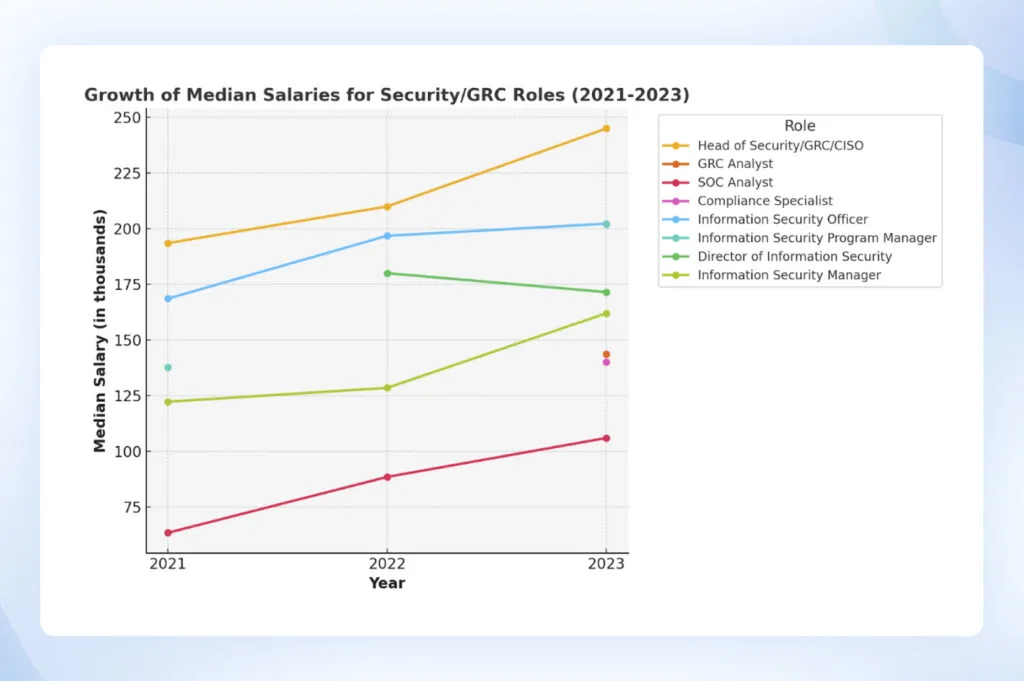
So, what does a typical roadmap look like?
Individuals often start with entry-level GRC roles from feeder positions such as IT Support, Network Administrator, or Security Administrator. These expose them to preliminary cybersecurity requirements and lay the foundation for understanding compliance frameworks.
However, to formally get into a GRC role, you might need to supplement your knowledge with certifications like Security+, GIAC Information Security Fundamentals, and Systems Security Certified Practitioner.
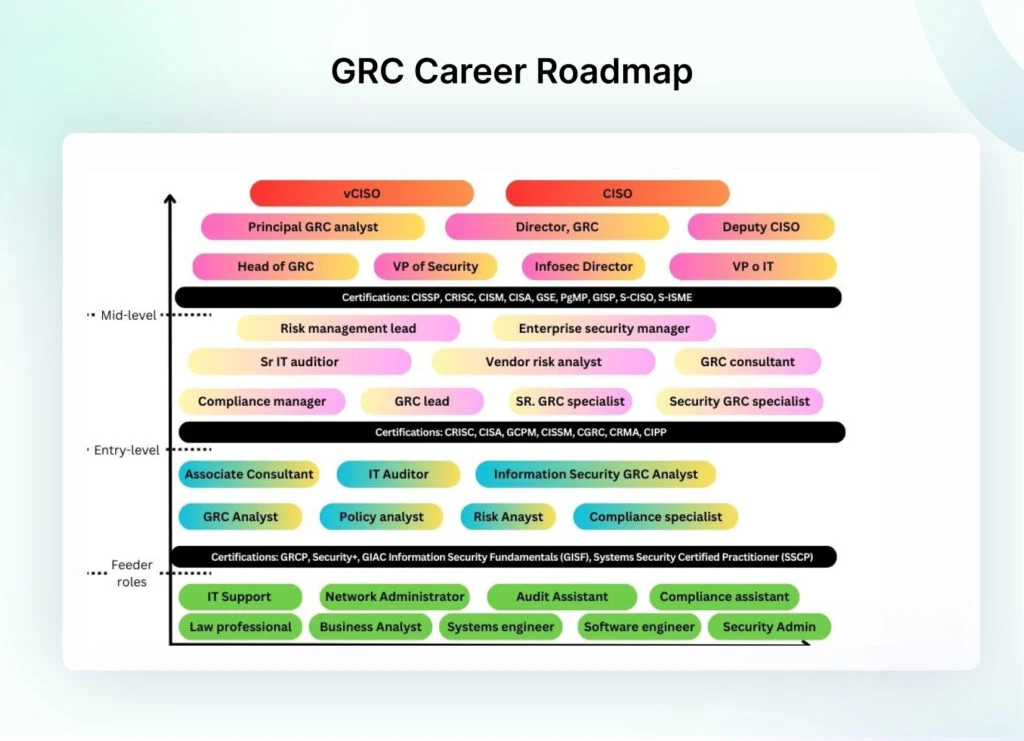
Here’s a summary of jobs you’ll do at each level
Entry-Level: You’re primarily assuming a support role here. Your responsibilities are focused on assisting with compliance tasks, mapping framework requirements to controls, documenting security policies, and executing basic risk assessments.
Mid-Level: Moving up, you transition into a managerial role where you’re executing, planning, and leading specific GRC projects. You interact more with other departments, providing guidance and ensuring that the GRC initiatives are integrated into broader organizational processes. Your role becomes crucial for bridging the gap between high-level policy directives and their practical implementation – devising frameworks that reflect the business’s reality and operational requirements and advising senior management.
Senior-Level to CISO: Your role is highly strategic at the executive level, especially as a CISO. You’re expected to make decisions shaping the organization’s long-term security posture and compliance strategy. You’ll interact with the highest levels of management, devise and influence company-wide policies, and represent your organization in front of stakeholders and regulators. Your role is pivotal in steering the organization through complex security landscapes, making decisions that not only protect but also enable the business.
But what exactly are hiring managers demanding from entry-level candidates?
We systematically analyzed over 100 active full-time job postings on LinkedIn collected within the past six months, primarily focusing on the North American region. Using targeted keywords related to GRC and cybersecurity, we filtered postings to ensure regional relevance.
Each selected job listing was examined to extract essential data points, including required technical and soft skills, necessary certifications, familiarity with cybersecurity frameworks (such as NIST and ISO 27001), experience levels, and certifications that were preferred at each skill level.
Here’s what we found:
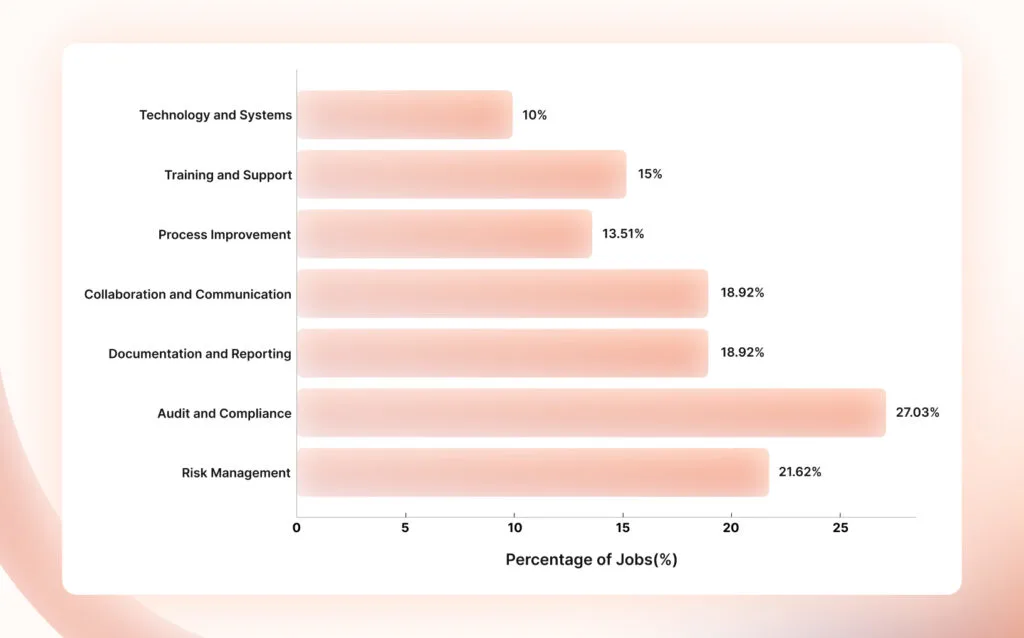
At the entry-level, employers tend to prioritize a broad understanding of GRC concepts over hands-on experience with specific tools and processes. Rather than being involved in strategy or high-level planning, entry-level professionals act as the ‘boots on the ground,’ performing the manual work necessary to implement and support senior team members’ initiatives.
While practical experience is less critical at this stage, a working knowledge of risk assessments, threat detection, compliance, and audit processes is essential to contribute effectively and help streamline operations.
Here are the top skills (with corresponding percentages) revealed through our analysis, indicating the proportion of job descriptions that specifically required these skills.
- Risk Management: At least 21.62% of organizations expect entry-level analysts to be able to support (if not conduct) vendor and operational risk assessments using standardized tools and methods.
- Audit and Compliance: At least 27% of entry-level job postings demand an understanding and knowledge of key frameworks, such as SOC 2 for service organizations, ISO 27001 for information security management, and NIST for cybersecurity risk management.
- Documentation and Reporting: Nearly 19% of entry-level jobs emphasize the importance of documentation and reporting skills. Entry-level employees are often responsible for tracking policies, maintaining records of compliance activities, tracking audit findings, and ensuring that documentation is complete and accurate for internal and external stakeholders.
- Security Awareness and Training: Around 11% mention in entry-level postings that they expect professionals to assist in security awareness and training programs. This includes supporting the development and delivery of training materials, such as security best practices, phishing awareness campaigns, and compliance training.
However, there’s a disconnect in the certifications desired for entry-level roles
Our analysis of job descriptions for entry-level GRC roles shows that 10-20 % of jobs desired progress toward advanced certifications like CISSP. In comparison, 17% of job descriptions mandated beginner-level certifications like CompTIA Security+.
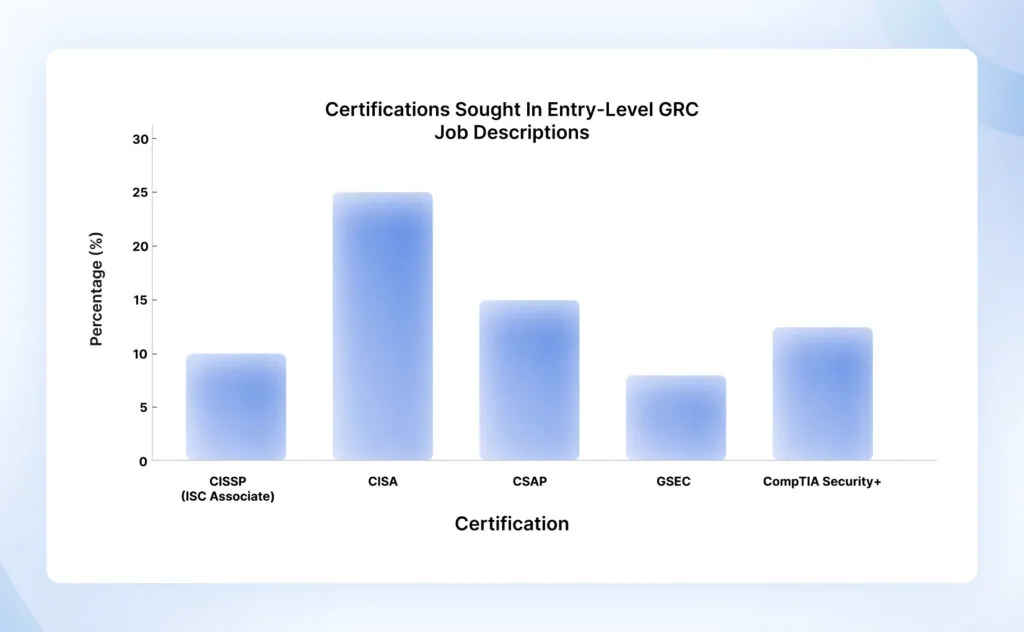
| Certification | Required/Desired | Comments |
| CISSP (ISC2 Associate) | Desired | Even though CISSP is an advanced certification that requires a minimum of 5 years of experience, candidates can make progress toward it by appearing for the exam. |
| CISA | Desired | The CISA certification is targeted at intermediate-level professionals. However, candidates can qualify for a 3-year experience waiver and take the exam earlier. |
| CSAP | Required | CSAP (Certified Security Awareness Practitioner) is less commonly required. Still, in roles that focus on security awareness, it can be seen as a crucial certification that demonstrates practical skills in implementing and maintaining security awareness programs. |
| GSEC | Desired | GSEC (GIAC Security Essentials) is highly relevant for entry-level professionals because it covers information security fundamentals, including hands-on skills that are valuable in GRC roles. |
| CompTIA Security+ | Required | CompTIA Security+ is one of the most common and foundational cybersecurity certifications, highly relevant for GRC roles that touch on cybersecurity, compliance, and risk management. It covers essential knowledge for securing systems and is widely accepted for entry-level positions. |
This disconnect also echoes the findings of a study conducted by (ISC)2 where they found that hiring managers cited certifications requiring several years of experience for entry-level roles.
There’s a paradox in the job market for entry-level roles: many demand certifications like CISSP or CRISC, but these credentials alone don’t substitute for real-world experience. Employers need to focus on nurturing talent with in-house training, while candidates should prioritize hands-on experience—through internships, volunteer work, or projects—before pursuing advanced certifications. Building foundational skills first creates a balanced, competent workforce, rather than confidence without capability.
Rachna Dutta, Infosec Consultant
What frameworks should you know as an entry-level candidate?
The analysis also suggested that NIST, ISO 27001, and SOC 2 are the most frequently mentioned frameworks, appearing in more than 20% of the entry-level job descriptions.
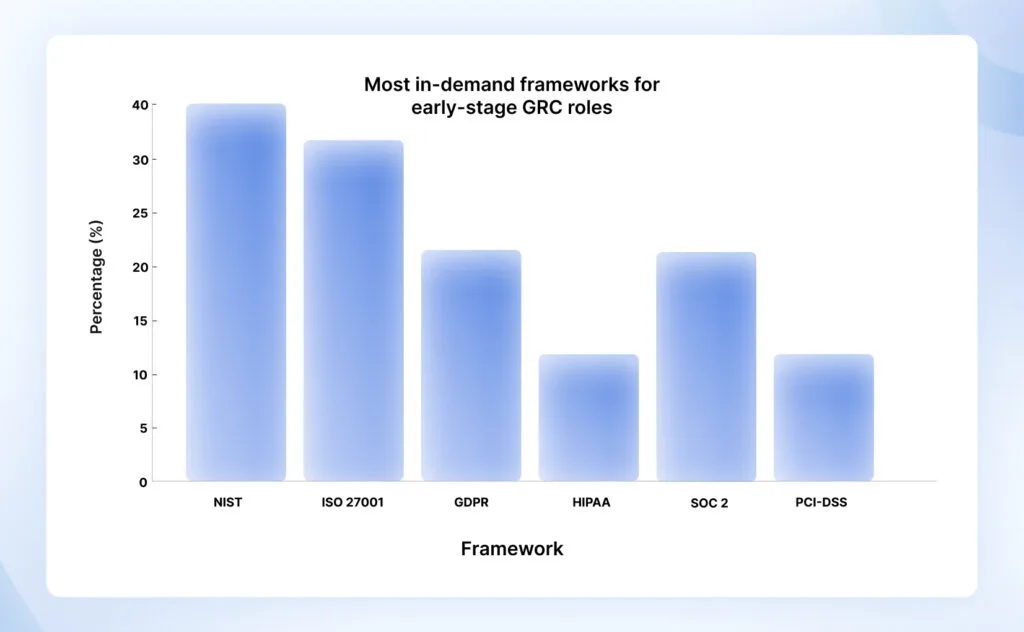
What do hiring managers look for at the mid-level?
After analyzing over 100+ job postings on Linkedin, we extracted critical insights that reveal the skills, and certifications demanded from professionals looking to find their next mid-level role in GRC cybersecurity. We also analyzed how these expectations in terms of responsibilities differ as we move away from junior roles.
And here’s what we found:
In mid-level GRC roles, professionals must be multifaceted experts who blend technical proficiency with strong execution and interpersonal skills.
They are primarily responsible for leading and ensuring the success of specific GRC initiatives like complying with a certain standard, implementing certain controls, or coordinating audits.
The role also demands them to assess and mitigate risks using quantitative and qualitative methods, including those from third-party vendors, and report findings to superiors like the Head of Compliance, VP of Infosec, or a CISO. These roles demand proficiency in developing and implementing comprehensive policies aligned with regulations such as NIST, ISO 27001, GDPR, and others, while effectively utilizing GRC tools to automate compliance processes.
Mid-level professionals must also coordinate internal and external audits to maintain compliance.
Here’s what analysis of 100+ job descriptions posted on Linkedin by companies of all sizes revealed:

CISSP and CISM are the certifications most desired at this level, suggesting that companies prioritize strong risk management skills in mid-level professionals.
The analysis also reveals that even mid-level employers expect some progress toward advanced certifications like CRISC, while over 35% of companies mandate certifications like CISA.
After risk management, certifications that assess one’s skills as an auditor, like CISA, are primarily sought by employers that hire GRC professionals to lead specific audit initiatives.
Regarding skills, most (more than 70%) of job descriptions emphasize skills in conducting risk assessments, driving regulatory compliance success, and coordinating audits.

However, 40-60 % of jobs also demanded nuanced and specific skills like policy development, vendor risk management, and technical proficiency with GRC tools like Sprinto, OneTrust, and LogicGate.
When it comes to compliance frameworks, NIST appears in 50% of the job descriptions, making it the most common framework for mid-level roles.

- ISO 27001, SOC 2, and PCI-DSS appear in approximately 45% of the job descriptions, showing their significant importance.
- GDPR and HIPAA appear less frequently but are still substantial, each showing up in around 27% of the roles.
How are expectations changing as you move from entry-level to mid-level?
As professionals advance from entry-level to mid-level roles in GRC, the shift is more than just an increase in responsibility; it’s transitioning from a tactical focus to a strategic one. Entry-level roles are centered around supporting existing processes and ensuring adherence to established frameworks under the supervision of senior professionals. In contrast, mid-level roles demand professionals to take ownership of broader organizational objectives, strongly emphasizing strategic risk resilience and curbing compliance drift. This transition involves deeper engagement in decision-making, leadership, and driving forward-thinking initiatives.
It’s a shift from tactical execution to strategic ownership, where mid-level professionals step into roles with greater governance and oversight responsibilities, engaging deeply with risk and decision-making to drive meaningful, forward-looking change.
Rachna Dutta, Infsosec Consultant
“It’s a shift from tactical execution to strategic ownership, where mid-level professionals step into roles with greater governance and oversight responsibilities, engaging deeply with risk and decision-making to drive meaningful, forward-looking change.” – Rachna Dutta, Infosec Consultant
| Category | Entry-Level Focus | Mid-Level Focus |
| Risk Management | Assistance in assessments | Lead risk assessments, vendor risk management |
| Compliance & Auditing | Gathering documentation and supporting audits | Leading audits, developing compliance frameworks |
| Technical Security | Hands-on, monitoring tools, running scans | Broader oversight, cloud security, automation |
| GRC Tools | Using tools, generating reports | Implementing & optimizing GRC tools |
| Project Management | Task-focused, supporting project activities | Leading projects, driving process improvements |
| Communication & Leadership | Internal communications, following instructions | Stakeholder engagement, leading training programs |
Key Differences:
- Leadership and Ownership: Mid-level professionals are expected to lead risk and compliance efforts, taking ownership of key projects and audits. They manage the implementation of GRC tools and ensure that processes remain efficient and compliant with regulations while contributing to strategic decisions on security and risk management.
- Autonomy and Decision-Making: Unlike entry-level roles that involve following established procedures, mid-level professionals operate with significant autonomy. They make key risk mitigation, vendor management, and compliance enforcement decisions, driving process improvements to minimize risk and avoid compliance gaps.
What do hiring managers expect from senior roles?
Moving from mid-level to senior-level, expectations shift significantly. Employers set stricter experience requirements, with over 80% of job postings specifying 8+ years of experience. Additionally, the demand for more advanced certifications becomes notably higher.
Here’s a breakdown of our analysis showcasing the most sought-after certifications for senior-level roles:
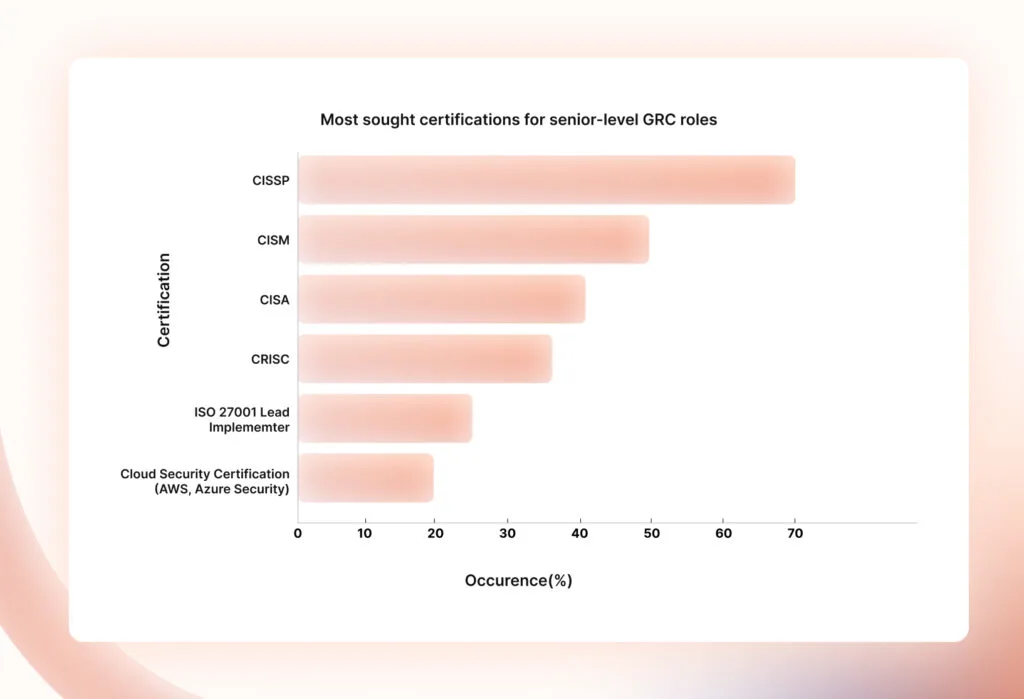
- CISSP and CISM dominate as the most common certifications, reflecting the vital need for senior GRC leaders to demonstrate a broad knowledge of security management and strategic leadership.
- CISA and CRISC certifications are sought after for roles that heavily emphasize risk management and compliance auditing, key areas of focus in governance, risk, and compliance.
- ISO 27001 and cloud security certifications are growing in importance, especially in highly regulated industries like finance, healthcare, and technology, where global security standards and cloud infrastructure are pivotal.
Diving deeper into the leadership role

When we look at the job descriptions for senior-level positions like VP, CISO, or CRO, a few things become evident:
- The expectations don’t end with just strategizing, developing, and overseeing cybersecurity initiatives but ensuring that they protect and enable business objectives. (Over 70% of the Job descriptions mention strategic resilience and risk management)
- The role also demands translating the language of risk into business impact for the board, helping them de-risk and visualize the true cost of business decisions.
- GRC leaders are seen as liability managers on all fronts – even financial and legal, required to deliver resilience with maximum efficiency.
And as you move from a mid-level professional to a senior one, this is how the expectations would change:
1) From ensuring success to strategic leadership:
- Senior-level roles, such as VP or CISO, require a high level of strategic oversight and the ability to influence risk management culture across the organization. These professionals often sit at the intersection of executive leadership and technical teams, guiding the overall security and compliance strategy.
- Mid-level roles are more tactical, focusing on implementing policies and ensuring the success of specific initiatives, while senior roles emphasize setting long-term goals, strategic planning, and aligning business and GRC objectives.
2) Broader Scope of Responsibility:
- Senior GRC professionals are responsible for managing liability overall, including a wide range of risk management areas like third-party risk, all external and internal threats, and adherence to all federal and regulatory mandates relevant to business.
- Mid-level roles are often focused on a narrower scope, such as managing day-to-day risk assessments, managing specific audits, or maintaining compliance with a particular standard (e.g., SOC 2 or ISO 27001).
3) Guiding enterprise culture
- Ability to sensitize the enterprise to the role and importance of information security — for example, employees Meet the information security baseline, Limit policy deviations, Make informed, independent risk decisions
- While mid-level professionals are tasked with devising training and participating in human risk management activities, they are not expected to make enterprise-wide decisions that can influence the culture from the ground up.
4) Policy and framework development:
- Senior-level roles are more involved in the creation and continual refinement of policies, frameworks, and compliance strategies, particularly ensuring they align with changing regulations and the organization’s long-term goals.
- Mid-level roles focus more on ensuring enterprise-wide adherence to established policies rather than developing or changing frameworks at a high level.
5) Communication and influence:
- Senior GRC leaders engage with board members, executives, and key stakeholders, using data and insights to drive decisions and influence risk culture. They are expected to provide high-level reporting on risk exposure and compliance trends.
- Mid-level professionals typically report to senior leadership and engage in more operational communications, such as presenting findings to immediate stakeholders or teams.
6) Data-driven decision making:
- Senior roles require an ability to assess risks and key risk indicators (KRIs) to prioritize action for maximum efficiency, increasing overall ROI and resilience.
- Mid-level roles focus on gathering, analyzing, and presenting data, enabling GRC leaders to make strategic decisions.
The bottom line
Choosing a career in GRC is embracing a journey filled with challenges and unparalleled opportunities. This path may not be linear or clearly marked, but that’s what makes it exciting and ripe for innovation.
Down the road, GRC’s success is all about becoming a strategic partner that enables businesses to navigate uncertainties with confidence. If you have a passion for resilience and security and a knack for understanding the intricate workings behind the scenes, you can chart a course that leads to significant career growth—even to the role of CISO.
So, equip yourself with knowledge, stay adaptable, and let your dedication to safeguarding organizations guide you.
The GRC landscape is wide open for those ready to lead—step into it with purpose and conviction.
Virgil
Virgil is a marketer at Sprinto who combines his media savvy with his cybersecurity expertise to craft content that truly resonates. Known for simplifying complex cybersecurity and GRC topics, he brings technical depth and a storyteller’s touch to his work. When he’s not busy writing, he’s likely exploring the latest in cybersecurity trends, debating geopolitics, or unwinding with a good cup of coffee.
Explore more
research & insights curated to help you earn a seat at the table.


















